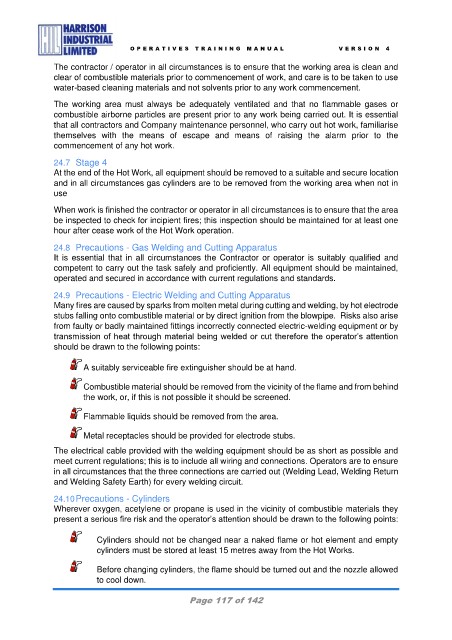Page 118 - HIL Operatives Training Manual V4 16022024_Neat
P. 118
O P E R A T I V E S T R A I N I N G M A N U A L V E R S I O N 4
The contractor / operator in all circumstances is to ensure that the working area is clean and
clear of combustible materials prior to commencement of work, and care is to be taken to use
water-based cleaning materials and not solvents prior to any work commencement.
The working area must always be adequately ventilated and that no flammable gases or
combustible airborne particles are present prior to any work being carried out. It is essential
that all contractors and Company maintenance personnel, who carry out hot work, familiarise
themselves with the means of escape and means of raising the alarm prior to the
commencement of any hot work.
24.7 Stage 4
At the end of the Hot Work, all equipment should be removed to a suitable and secure location
and in all circumstances gas cylinders are to be removed from the working area when not in
use
When work is finished the contractor or operator in all circumstances is to ensure that the area
be inspected to check for incipient fires; this inspection should be maintained for at least one
hour after cease work of the Hot Work operation.
24.8 Precautions - Gas Welding and Cutting Apparatus
It is essential that in all circumstances the Contractor or operator is suitably qualified and
competent to carry out the task safely and proficiently. All equipment should be maintained,
operated and secured in accordance with current regulations and standards.
24.9 Precautions - Electric Welding and Cutting Apparatus
Many fires are caused by sparks from molten metal during cutting and welding, by hot electrode
stubs falling onto combustible material or by direct ignition from the blowpipe. Risks also arise
from faulty or badly maintained fittings incorrectly connected electric-welding equipment or by
transmission of heat through material being welded or cut therefore the operator’s attention
should be drawn to the following points:
A suitably serviceable fire extinguisher should be at hand.
Combustible material should be removed from the vicinity of the flame and from behind
the work, or, if this is not possible it should be screened.
Flammable liquids should be removed from the area.
Metal receptacles should be provided for electrode stubs.
The electrical cable provided with the welding equipment should be as short as possible and
meet current regulations; this is to include all wiring and connections. Operators are to ensure
in all circumstances that the three connections are carried out (Welding Lead, Welding Return
and Welding Safety Earth) for every welding circuit.
24.10 Precautions - Cylinders
Wherever oxygen, acetylene or propane is used in the vicinity of combustible materials they
present a serious fire risk and the operator’s attention should be drawn to the following points:
Cylinders should not be changed near a naked flame or hot element and empty
cylinders must be stored at least 15 metres away from the Hot Works.
Before changing cylinders, the flame should be turned out and the nozzle allowed
to cool down.
Page 117 of 142

